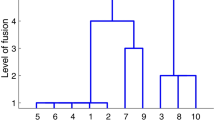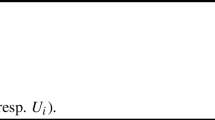Abstract
The additive clustering approach is applied to the problem of two-mode clustering and compared with the recent error-variance approach of Eckes and Orlik (1993). Although the schemes of the computational algorithms look very similar in both of the approaches, the additive clustering has been shown to have several advantages. Specifically, two technical limitations of the error-variance approach (see Eckes and Orlik 1993, p. 71) have been overcome in the framework of the additive clustering.
Similar content being viewed by others
References
ARABIE, P., and HUBERT, L. (1992), “Combinatorial Data Analysis,”Annual Review of Psychology, 43, 169–203.
ARABIE, P., SCHLEUTERMANN, S., DAWS, J., and HUBERT, L. J. (1988), “Marketing Applications of Sequencing and Partitioning of Nonsymmetric and/or Two-mode Matrices”, inData, Expert Knowledge and Decision, Eds., W. Gaul, and M. Schader, Berlin: Springer-Verlag, 215–224.
BASS, F. M., PESSEMIER, E. A., and LEHMANN, D. R. (1972), “An Experimental Study of Relationships between Attitudes, Brand Preference, and Choice,”Behavioral Science, 17, 532–541.
BRAVERMAN, E.M., KISELEVA, N.E., MUCHNIK, I.B., and NOVIKOV, S.G. (1974), “Linguistic Approach to the Problem of Processing Large Bodies of Data”,Automation and Remote Control, 35, (11, part 1), 1768–1788.
CARLIER, A., and KROONENBERG, P. M. (1993), “Biplots and Decompositions in Twoway and Three-way Correspondence Analysis,” inPublications du Laboratoire de Statistique et Probabilités, Université Paul Sabatier, Toulouse (France), 01-93, 1–31.
COLOMBO, R. A., and MORRISON, D. G. (1989), “A Brand Switching Model with Implications for Marketing Strategies”,Marketing Science, 8, 89–99.
DESARBO, W. S. (1982), ‘GENNCLUS: New Models for General Nonhierarchical Clustering Analysis,”Psychometrika, 47, 446–449.
DESARBO, W. S., and DE SOETE, G. (1984), “On the Use of Hierarchical Clustering for the Analysis of Nonsymmetric Proximities,”Journal of Consumer Research, 11, 601–610.
ECKES, T., (1993), “A Two-mode Clustering Study of Situations and Their Features”, inInformation and Classification, Eds., O. Opitz, B. Lausen, and R. Klar, New York: Springer-Verlag, 510–517.
ECKES, T., and ORLIK, P. (1991), “An Agglomerative Method for Two-mode Hierarchical Clustering,” inClassification, Data Analysis, and Knowledge Organization, Eds., H.-H. Bock and P. Ihm, Berlin: Springer-Verlag, 3–8.
ECKES, T., and ORLIK, P. (1993), “An Error Variance Approach to Two-mode Hierarchical Clustering,”Journal of Classification, 10, 51–74.
GREENACRE, M. J. (1984),Theory and Applications of Correspondence Analysis, London: Academic Press.
GREENACRE, M., and BLASIUS, J. (Eds.) (1994),Correspondence Analysis: Recent Developments and Applications, New York: Academic Press.
HARTIGAN, J.A. (1972), “Direct Clustering of a Data Matrix”,Journal of American Statistical Association, 67, 123–129.
HARTIGAN, J. A. (1976), “Modal Blocks in Dentition of West Coast Mammals”,Systematic Zoology, 25, 149–160.
LEBART, L., and MIRKIN, B. (1993), “Correspondence Analysis and Classification”, inMultivariate Analysis: Future Directions 2., Amsterdam: Elsevier, 341–357.
LEBART, L., MORINEAU, A., and WARWICK, K. M. (1984),Multivariate Descriptive Statistical Analysis: Correspondence Analysis and Related Techniques for Large Matrices (E. M. Berry, Trans.), New York: Wiley. (Original work published 1977).
MIRKIN, B. (1987), “Additive Clustering and Qualitative Factor Analysis Methods for Similarity Matrices,”Journal of Classification, 4, 7–31; (1989) Erratum,6, 271–272.
MIRKIN, B., “Clustering for Contingency Tables: Boxes and Partitions”,Statistics and Computing, in press.
MIRKIN, B., and ROSTOVTSEV, P. S. (1978), “Method to Reveal Associated Subsets of the Variables”, inModels for Socioeconomic Data Aggregation, Ed., B. Mirkin, Novosibirsk, Institute of Economics Press, 107–112.
NISHISATO, S. (1980),Analysis of Categorical Data: Dual Scaling and Its Applications, Toronto: University of Toronto Press.
NISHISATO, S. (1994),Elements of Dual Scaling, Hillsdale, NJ: Erlbaum.
PACKER, C.V. (1989), “Applying Row-Column Permutation to Matrix Representations of Large Citation Networks”,Information Processing & Management, 25, 307–314.
PRICE, R. H. (1974), “The Taxonomic Classification of Behaviors and Situations and the Problem of Behavior-Environment Congruence,”Human Relations, 27, 567–585.
PRICE, R. H., and BOUFFARD, D. L. (1974), “Behavioral Appropriateness and Situational Constraint as Dimensions of Social Behavior,”Journal of Personality and Social Psychology, 30, 579–586.
SHEPARD, R. N., and ARABIE, P. (1979), “Additive Clustering: Representation of Similarities as Combinations of Discrete Overlapping Properties,”Psychological Review, 86, 87–123.
Author information
Authors and Affiliations
Additional information
The research was supported by the Office of Naval Research under grant number N0014-93-1-0222 to Rutgers University. The authors are indebted both to Fionn Murtagh, who served as Acting Editor, and to anonymous Referees for thoughtful and constructive reviews.
Rights and permissions
About this article
Cite this article
Mirkin, B., Arabie, P. & Hubert, L.J. Additive two-mode clustering: The error-variance approach revisited. Journal of Classification 12, 243–263 (1995). https://doi.org/10.1007/BF03040857
Issue Date:
DOI: https://doi.org/10.1007/BF03040857




